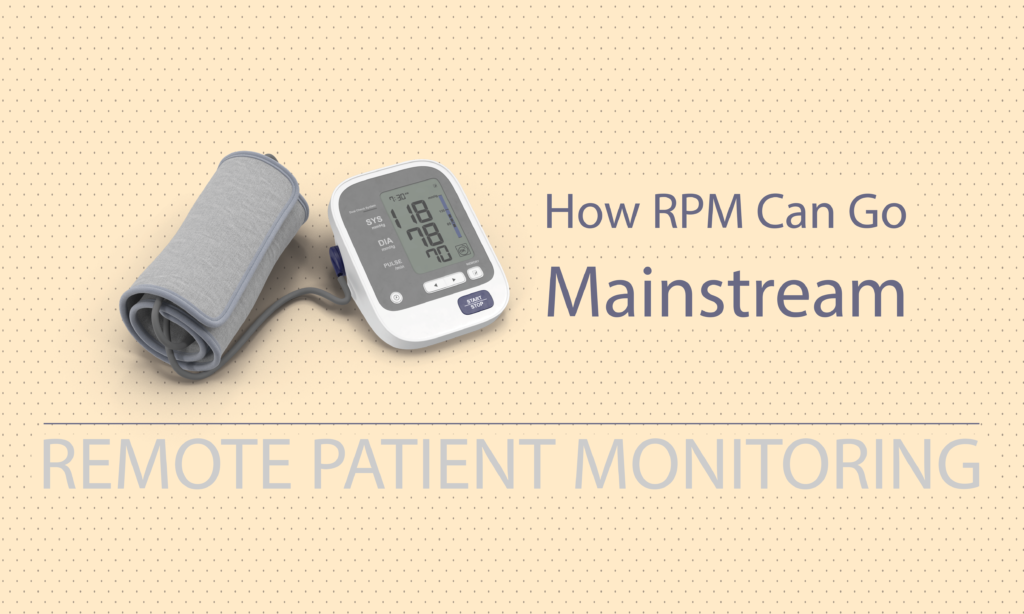Remote Patient Monitoring (RPM) has established itself as an essential care delivery tool that goes beyond its intended use during the pandemic. Back then, RPM was able to provide care without patients stepping out of their houses. At present, the program has kept countless patients avoiding high-cost settings and expanded access to care. It enhances the patient experience by allowing care to be delivered in the comfort of the patient’s homes while they cut on transportation or fuel costs.
Hence, RPM is poised to go mainstream as more providers and patients acknowledge its value in providing timely, relevant, and cost-effective care. For patients with chronic conditions, RPM services keep a watchful eye on their key numbers to prevent an escalation that can lead to a costly ER visit or hospitalization.
What impact has the pandemic had on chronic conditions? How can RPM help?
RPM can greatly aid providers treating chronic conditions and ease overburdened hospitals.
Though still relatively new since it was first introduced in 2018 by the Center for Medicare and Medicaid Services (CMS), RPM’s potential for growth is impressive. The RPM market is now filled with a wide array of clinical-grade devices that patients can use to measure vital signs that include blood pressure, blood oxygen level, EKG, heart rate, and heart rate variability.
The technology continues to advance with more devices and wearables capturing more clinically-relevant data than before.
So how has RPM reached its current status as a must-have healthcare tool?
RPM during and beyond the pandemic
At the height of the pandemic and when hospitalization rates were at their highest, an RPM enforcement policy was issued by the FDA. RPM was the emergency solution to provide badly needed care when in-office visits were too risky and clinical staff were overworked.
RPM devices like connected thermometers and stethoscopes as well as spirometers and pulse oximeters monitor COVID patients and enabled home-based quarantine. The data collected guide clinicians in identifying those who need in-patient care. The use of a digital solution eased the burden on overwhelmed hospitals and their staff.
Now that in-office visits have resumed, the healthcare system is facing a huge “health debt” accrued during the pandemic when patients were delaying care for fear of contracting the virus. For chronic patients, delaying care could have long-term consequences. RPM can mitigate these with its timely intervention because it is able to see what’s happening to the patients when they are not in the doctor’s office.
RPM devices capture and transmit patient data in real-time so clinicians can easily ascertain the patient’s blood glucose levels, vital signs, and heart rhythm changes live. The data are used to support sound clinical decision-making to assess the best course of action to avoid an ER visit. RPM enables the effective management of treatments and adherence. It also reduces the patient risk of chronic care patients by collecting data remotely.
Studies have shown that RPM has been effective in reducing readmissions and ER visits among chronic care patients, which account for the biggest share of total healthcare expenditures. It has also helped patients meet their health goals and produce better health outcomes. Hence, an increasing number of providers are becoming more accustomed to using RPM in their clinical practice.
So, is RPM going mainstream?
RPM innovations on wearables
RPM can be used effectively to manage chronic conditions like diabetes where patients can use at-home glucometers, but some conditions like COPD, atrial fibrillation, and sleep apnea require devices that can adequately monitor them. As of the moment, providers are only seeing a part but not the whole picture in these aforementioned conditions.
The latest RPM and RTM (remote therapeutic monitoring) trends are showing huge advancements in technology, particularly in the wearables market. Several mainstream companies have started their own line of wearables that have been approved by the FDA. The healthcare industry is becoming more consumer-oriented with consumer-facing tech giants like Apple, Google, Amazon, and Samsung launching mainstream wearables. For example, Apple Watch now has an FDA-cleared EKG monitor.
These tech companies are also shifting consumer habits with more people invested in monitoring their health even including blood pressure and blood glucose levels. If and when providers recommend a device, patients will more likely use it.
Remote monitoring is set to be in the mainstream in 10 years and it will be reimbursed by major payers. Companies are investing in innovative ways to capture vital signs and other relevant data because RPM works in preventing escalations and reducing total healthcare costs. Aside from wearables, there are also new innovations in smartphone or laptop cameras, breathalyzers as well as various sensors like epidermal sensors, subcutaneous sensors, and sensors in clothing.
In 10 years, patients may no longer need to exert any effort in measuring vital signs because subcutaneous sensors can do it. In fact, there is already an FDA-cleared implantable sensor for glucose monitoring.
Wearables for chronic conditions
The clinical applications of wearables are set to be wide-reaching and eventually, wearables for chronic conditions will follow. COPD patients, epileptic patients, and cardiac patients still need long-term and clinically-relevant devices to better manage their conditions. Some complex conditions are still monitored manually for lack of a tool that identifies trends to make changes to the trajectory of care.
Innovations in wearables are very promising for it is working towards transforming fitness wearables into clinical diagnostic devices. The goal is to have accurate and clinically relevant data when combined with AI can significantly enhance care and provider faster preventative care than ever before.
Improvements in design and usability can also enhance patient experience and positively impact outcomes. With AI leveraging analytics, predictive capabilities will improve and so will intervention and management. Better collection of data will be able to meet precision medicine needs.
An opportunity to go mainstream
The pandemic has shown the efficacy of RPM as an effective healthcare tool. The important lesson now is that users have been willing to use it and create opportunities for companies to invest in RPM innovations. Adoption and usability may still be big issues in healthcare technology, especially for senior chronic care patients, but advancements may soon overcome these. The pandemic has shown how many individuals regardless of age and tech literacy have quickly adopted remote tools like telemedicine.
Patients can become more engaged in self-managing their health when they can get feedback on their health data. Longitudinal data will enable more relevant feedback and when usability is enhanced, it will also improve adoption and adherence.
RPM and innovative wearables will offer valuable insights that include preventative care applications to understanding the complexity of chronic conditions. If providers and patients alike can fully grasp the importance of this RPM data, then the solution will eventually be a part of standard care delivery.
Do you want to participate now in providing an innovative care solution?
Ascent Care Partners (ACP) provide turnkey RPM solutions to help practices participate in innovating their care delivery and in Medicare’s reimbursement programs. Along with our Chronic Care Management (CCM) solution, you can synchronize care without the risk of increased overhead. RPM and CCM provide wraparound care that allows your practice to grow clinically and financially.



